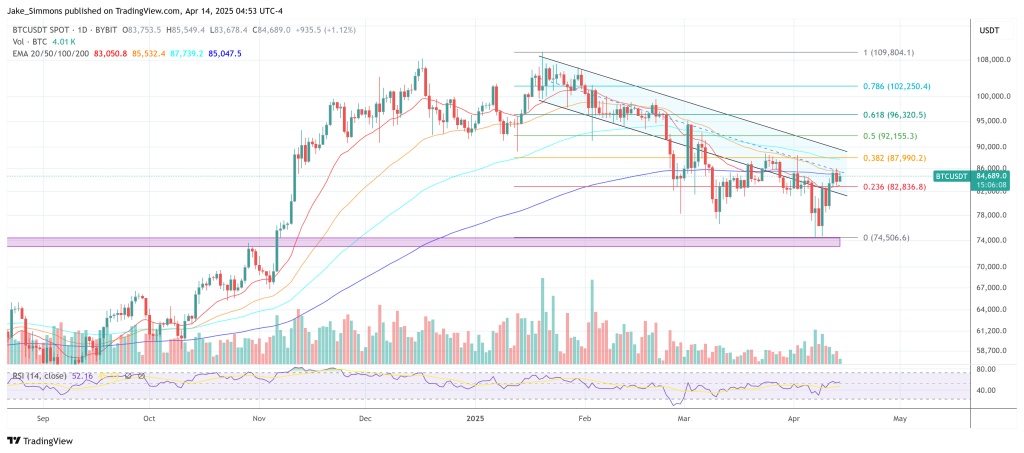Last week was defined by simultaneous declines in US equities, Treasurys, and the dollar—an exceptionally rare trifecta that macro investor Jordi Visser described as the moment “the system officially broke”—Bitcoin’s price action has remained conspicuously muted. Despite gold rallying over 4% in just a few days, Bitcoin has failed to respond with comparable strength, a divergence that Visser attributes to deep-rooted skepticism from institutional finance.
Visser, president and CIO of Weiss Multi-Strategy Advisers and a veteran of over three decades on Wall Street, sat down for an in-depth interview with Anthony Pompliano to unpack what he called a historic rupture in the global capital structure. Central to his thesis is that US government bonds—long considered the most risk-free asset in the world—are no longer behaving as such. “The top of the global capital structure, the safest asset in the world, is falling,” Visser said, referring to US Treasurys underperforming even against other sovereign debt.
Month-to-date, he noted, US bonds are down over 5%, equities have also dropped more than 5%, and the US dollar index is off by a similar magnitude. “The currency, bonds, and stocks all going down in a panic way—that doesn’t happen. The last time I saw that was in emerging markets,” Visser said, drawing parallels to financial crises he observed firsthand in Brazil during the 1990s.
What This Means For Bitcoin
The implications for Bitcoin in this environment are complex. While many in the crypto community expected BTC to surge amid macro instability, Visser says Wall Street still views Bitcoin through an equity-like lens. “Wall Street doesn’t believe in Bitcoin,” he said bluntly. “The problem is the view on Bitcoin is that it’s NASDAQ. So I don’t think it should be skyrocketing like gold yet. That happens when we get the printing press turned on again—which is going to have to happen.”
According to Visser, Bitcoin’s underperformance relative to gold is not a repudiation of its long-term thesis but rather a reflection of who holds what, and when they’re allowed to act. “Gold’s a different story. Sovereign wealth funds already own it. Central banks already own it. Hedge funds love to buy gold. Bitcoin? Not yet.” He emphasized that Bitcoin’s moment will likely come not amid the crisis itself, but in its aftermath, when monetary authorities begin resorting to aggressive stimulus—what he termed “debasement,” historically the go-to solution in past crises.
Visser was adamant that despite Bitcoin’s price inertia, it is in fact doing its job: “Bitcoin is the digital asset of the digital economy.” In his view, the current turmoil marks the transition from a unipolar, dollar-centric world to a fragmented, multipolar one. “We’re entering a new world, and this new system is decentralized,” he said. That transition, accelerated by both geopolitical fragmentation and advances in AI, is unlikely to be smooth. Visser predicts increased volatility and declining trust in legacy financial infrastructure, which could serve as long-term tailwinds for Bitcoin.
His analysis ties Bitcoin’s trajectory closely to global liquidity cycles, noting that much of the world’s debt is denominated in US dollars. As such, a falling dollar paradoxically boosts liquidity globally, particularly for emerging markets and risk assets. “Bitcoin will be four to eight weeks—four to 10 weeks—later,” he said, referring to its lagging correlation with liquidity expansions. “You’ll look back eight weeks from now and say, ‘I can’t believe I didn’t see they were going to print to stop this thing.’ They do it every single time.”
Still, he was clear-eyed about the near-term structural headwinds. Institutional allocators, especially hedge funds, face two major constraints: investor redemptions and prime broker margin requirements. “Wall Street has an embedded side that prevents them from going through it,” Visser explained. “Retail just buys more on the dip. Wall Street can’t.”
Even in the face of institutional hesitancy, Visser underscored that the global conversation around trade, capital flows, and currency trust is now permanently altered. “Does the US want to be the reserve currency anymore?” he asked. “From a government official perspective in trade, it’s no longer the reserve currency. The trade deficit has been put in by the administration.”
The consequence, he warned, is that the US is now effectively exporting fiscal deficits to other nations as global trade recedes. In such a world—where nationalism replaces globalism and bilateral trust continues to erode—Visser believes decentralized systems will inevitably grow more relevant.
“I do think the agreement will end up being that decentralization will speed up from here because of AI and because of crypto,” he said. But he cautioned that while the architecture is being laid, mainstream acceptance remains gated by perception, policy, and institutional adoption cycles.
In sum, Visser sees Bitcoin not as a failed safe haven, but as an emergent asset still waiting for its structural breakout moment. Until Wall Street stops viewing Bitcoin as a risk-on tech proxy—and until central banks inevitably revert to monetary stimulus—BTC will remain in the shadows of gold. But he was unequivocal in where he believes it’s headed. “We are getting closer to that day every single day,” he said, referring to the moment when Bitcoin’s role in the global capital system finally clicks into place.
As Visser sees it, the system may be broken—but that’s precisely how something new gets built.
At press time, BTC traded at $84,689.


















